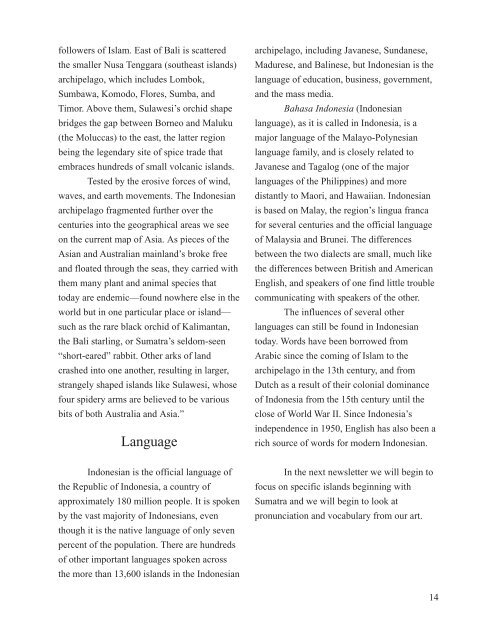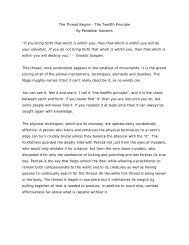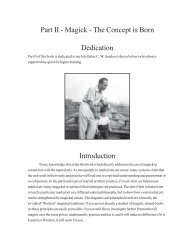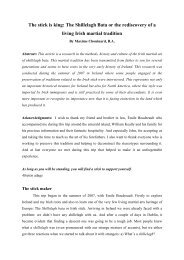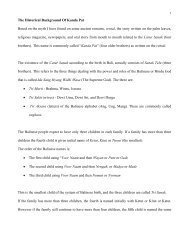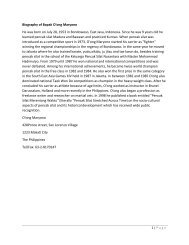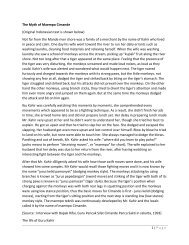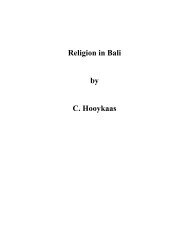Tenaga Dalam - Pukulan Cimande Pusaka
Tenaga Dalam - Pukulan Cimande Pusaka
Tenaga Dalam - Pukulan Cimande Pusaka
Create successful ePaper yourself
Turn your PDF publications into a flip-book with our unique Google optimized e-Paper software.
followers of Islam. East of Bali is scattered<br />
the smaller Nusa Tenggara (southeast islands)<br />
archipelago, which includes Lombok,<br />
Sumbawa, Komodo, Flores, Sumba, and<br />
Timor. Above them, Sulawesi’s orchid shape<br />
bridges the gap between Borneo and Maluku<br />
(the Moluccas) to the east, the latter region<br />
being the legendary site of spice trade that<br />
embraces hundreds of small volcanic islands.<br />
Tested by the erosive forces of wind,<br />
waves, and earth movements. The Indonesian<br />
archipelago fragmented further over the<br />
centuries into the geographical areas we see<br />
on the current map of Asia. As pieces of the<br />
Asian and Australian mainland’s broke free<br />
and floated through the seas, they carried with<br />
them many plant and animal species that<br />
today are endemic—found nowhere else in the<br />
world but in one particular place or island—<br />
such as the rare black orchid of Kalimantan,<br />
the Bali starling, or Sumatra’s seldom-seen<br />
“short-eared” rabbit. Other arks of land<br />
crashed into one another, resulting in larger,<br />
strangely shaped islands like Sulawesi, whose<br />
four spidery arms are believed to be various<br />
bits of both Australia and Asia.”<br />
Language<br />
archipelago, including Javanese, Sundanese,<br />
Madurese, and Balinese, but Indonesian is the<br />
language of education, business, government,<br />
and the mass media.<br />
Bahasa Indonesia (Indonesian<br />
language), as it is called in Indonesia, is a<br />
major language of the Malayo-Polynesian<br />
language family, and is closely related to<br />
Javanese and Tagalog (one of the major<br />
languages of the Philippines) and more<br />
distantly to Maori, and Hawaiian. Indonesian<br />
is based on Malay, the region’s lingua franca<br />
for several centuries and the official language<br />
of Malaysia and Brunei. The differences<br />
between the two dialects are small, much like<br />
the differences between British and American<br />
English, and speakers of one find little trouble<br />
communicating with speakers of the other.<br />
The influences of several other<br />
languages can still be found in Indonesian<br />
today. Words have been borrowed from<br />
Arabic since the coming of Islam to the<br />
archipelago in the 13th century, and from<br />
Dutch as a result of their colonial dominance<br />
of Indonesia from the 15th century until the<br />
close of World War II. Since Indonesia’s<br />
independence in 1950, English has also been a<br />
rich source of words for modern Indonesian.<br />
Indonesian is the official language of<br />
the Republic of Indonesia, a country of<br />
approximately 180 million people. It is spoken<br />
by the vast majority of Indonesians, even<br />
though it is the native language of only seven<br />
percent of the population. There are hundreds<br />
of other important languages spoken across<br />
the more than 13,600 islands in the Indonesian<br />
In the next newsletter we will begin to<br />
focus on specific islands beginning with<br />
Sumatra and we will begin to look at<br />
pronunciation and vocabulary from our art.<br />
14


